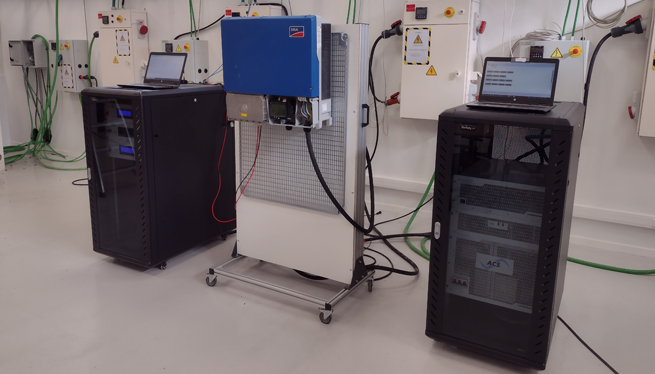ENGIE Laborelec has developed an innovative method to assess whether PV plant design and inverters comply with the grid code, involving setting up a sophisticated test bench.
While grid code compliance in small-scale installations (up to several kW) can simply be assessed by checking the power output of a single converter, the matter is much more complicated in large-scale PV plant where hundreds of multi-MW inverters are connected. Even where inverters comply individually, compliance at the grid connection point is not guaranteed unless the entire architecture as a whole is evaluated. An additional challenge is that OEMs are reluctant to take responsibility for grid code compliance when their inverters are used on such a large scale.
Insight into the inverters’ real capabilities and behaviours
That’s why ENGIE Laborelec has developed an innovative method to assess the grid code compliance of the combined output of a series of inverters of the same type. Laborelec experts determined that the key to solving the puzzle is to acquire in-depth insight into the inverter’s real capabilities beyond specification, as well as the device’s control algorithms, aspects that OEMs avoid talking about.
But since large multi-MW inverters cannot be tested in a laboratory, Laborelec experts developed an approach which involved testing small-scale inverters to gain experience and make accurate predictions.
Exposing the grid to massive PV power production — virtually
The experts subsequently developed an integrated setting in which to safely test a single 50-kW inverter connected to a controllable DC source — representing PV panels, and a controllable bi-directional power source — representing the grid. The inverter can then be exposed virtually to multiple renewable power production scenarios in a variety of grid situations.
When running the scenarios, multiple measurements are constantly carried out at the virtual grid connection point to evaluate grid code compliance. The service has already been of great value to ENGIE, says Laborelec expert Stijn Uytterhoeven: “We have been able to give solid reassurance to ENGIE engineers that their PV plant designs will not violate the local grid code.”
The test bench has served other purposes too. For example, it has been used to test whether the Belgian distribution grid’s capacity is sufficiently strong to withstand the rapid dynamic injection of current from a PV plant in the event of a short circuit. The conclusion was in the affirmative.




